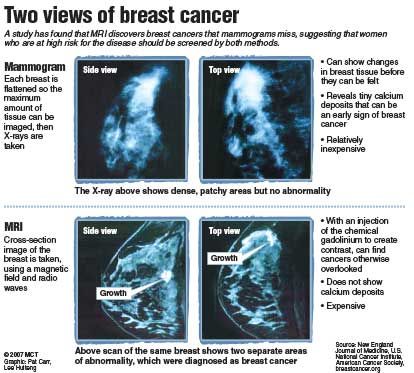Breast cancer is defined as a malignant tumor that starts in the cells of the breast. It is apart of a group of cancer cells that can grow into surrounding tissue and spread to distant areas of the body. The disease usually occurs in women, but men can suffer from it as well. It’s the most common cancer in women other than skin cancer. It is also the second leading cancer in women after lung cancer. The chance of a woman having invasive breast cancer at some point during their life is less that one in eight. The chance of dying from breast cancer is about one in 36.
There are many different forms of breast cancer, which are based on how they appear under a microscope. These forms include ductal carcinoma in situ, invasive ductal carcinoma, invasive lobular carinoma, inflammatory breast cancer, Paget disease of the nipple, phyllodes tumor, and angiosarcoma. Once the form of breast cancer has been identified, the treatment for that specific form can also be identified and performed. These treatments include but are not limited to surgery, radiation therapy, chemotherapy, hormone therapy, targeted therapy, and bone-directed therapy. They are classified into broad groups called local versus systemic therapy and adjuvant and neoadjuvant therapy. In addition to theses procedures and surgeries, medication is prescribed to help the patient after a procedure has been done, to work as a treatment, or even work along-side other treatments. These medications, prescribed according to the patient’s health, include carboplatin, docetaxal, doxorubicin, paclitaxel, tamoxifen, lapatinib, and trastuzumab.
Every person should be aware of the symptoms and signs of breast cancer, and anytime an abnormality is discovered, it should be researched and looked into by a healthcare professional. Most people who have breast cancer symptoms and signs will initially notice only one or two, an the presence of these symptoms and signs do not automatically mean that the patient has breast cancer. A few symptoms and signs include a change in how the breast or nipple feels, which pertains to nipple tenderness or a lump or thickening in or near the breast; a change in breast or nipple appearance, which pertains to swelling, shrinkage, and a change in texture; and any nipple discharge, particularly clear or bloody. By performing monthly breast self-exams, you will be able to easily identify any changes in your breast.
“People may think its weird to do the self exams but who knows your body better than you,” said Tawan Gradney, a 19-year-old sophomore nursing major from Kinder, Louisiana.
Patients dealing with breast cancer often are emotionally, mentally, spiritually, and sometime physically unstable. Patients often require palliative care, which is a specialized medical care for people with serious illnesses. It focuses on providing patients with relief from the symptoms, pain, and stress of a serious illness. The goal is to improve quality of life of the patient. Usually doctors, nurses and other specialist’s work together with a patient’s original doctor to provide an extra layer of support. It is appropriate that at any age or stage during a serious illness that this is provided along with curative treatment. Palliative care is also affective for the family of the patient being that they are almost always in close contact with the patient and they have to see them endure it.
“Seeing a loved one go through all that takes a toll on you emotionally,” said Airyanna Key, a 19-year-old nursing major from Crowley, Louisiana.
“Sometimes it makes you want to ball up and cry,” said Key.
Though breast cancer is affecting nearly 400,000 women in the United States, the fight must go on. With researching occurring daily and medicine advancing, there are hopes of one day breast cancer being obliterated.
Breast Cancer: Signs, Symptoms, and Prevention
October 17, 2014
0
More to Discover












